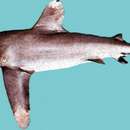Diagnostic Description
provided by Fishbase
A stocky shark with a huge, rounded 1st dorsal fin, and long, wide-tipped pectoral fins; snout bluntly rounded; upper teeth triangular; interdorsal ridge present (Ref. 5578). Back usually dark grey with a bronze tinge, sometimes brown or bluish; belly whitish, sometimes with a yellow tinge; tips off first dorsal, pectorals, and lower lobe of caudal often white or with white spots (sometimes absent); ventral surface of pelvic fins, apices of anal and second dorsal, and ventral lobe of caudal often with black spots; black or dusky saddle-marks in front of second dorsal, upper margin of caudal and between dorsal fins (especially in young) (Ref. 9997).
- Recorder
- Cristina V. Garilao
Life Cycle
provided by Fishbase
Viviparous, placental (Ref. 50449). Litter size 1-15 pups; 60-65 cm at birth (Ref. 244). Distinct pairing with embrace (Ref. 205).
Migration
provided by Fishbase
Oceanodromous. Migrating within oceans typically between spawning and different feeding areas, as tunas do. Migrations should be cyclical and predictable and cover more than 100 km.
- Recorder
- Kent E. Carpenter
Morphology
provided by Fishbase
Dorsal spines (total): 0; Dorsal soft rays (total): 0; Analspines: 0; Analsoft rays: 0
- Recorder
- Cristina V. Garilao
Trophic Strategy
provided by Fishbase
Occurs on the continental shelf (Ref. 75154).
Biology
provided by Fishbase
An oceanic deep-water species which sometimes comes close to shore (Ref. 244). Found surface to depths of at least 150 m (Ref. 26938). Epipelagic usually over water depths of >184 meters (Ref. 58302). Frequently accompanied by Remora, Coryphaena, pilot fishes (Ref. 30573), and tortoises. Feeds oceanic bony fishes, also threadfins, stingrays, sea turtles, sea birds, gastropods, squid, crustaceans, mammalian carrion and garbage (Ref. 5578), including tuna and mahimahi (Ref. 1602, 37816). Viviparous (Ref. 50449). There is pronounced partial segregation by size and sex in some areas. This is an active, almost fearless shark also charged in human attacks (Ref. 244). Probably responsible for many open-ocean attacks after air or sea disasters (Ref. 6871). Utilized fresh, frozen (Ref. 9987), smoked, and dried-salted for human consumption; hides for leather, fins for fin soup, liver oil for vitamins, also processed into fishmeal (Ref. 244). 1 to 15 young, 60 to 65 cm, are born per litter (Ref. 1602).
- Recorder
- Kent E. Carpenter
Importance
provided by Fishbase
fisheries: commercial; gamefish: yes
- Recorder
- Kent E. Carpenter

